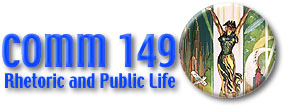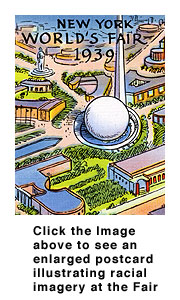
Office: HGH 210; phone: (408) 924-5378
Email: wooda@email.sjsu.edu
Web: http://www.sjsu.edu/faculty/wooda

|
Dr. Andrew Wood Office: HGH 210; phone: (408) 924-5378 Email: wooda@email.sjsu.edu Web: http://www.sjsu.edu/faculty/wooda |
 To support this thesis, Rydell describes discrimination in hiring practices and treatment at both the New York and San Francisco Fairs of 1939. African Americans represented a miniscule percentage of the Fairs' workforce. Moreover, they were generally placed in only the most menial jobs. As with previous fairs, their contributions to public life were either ignored or ghettoized in small pavilions. As we discussed previously, the experiences of African-Americans may therefore be compared to that of women at Fairs like the Columbian Exposition. For African-Americans, this discrimination was reduced somewhat between the 1939 and 1940 Fair - but not for altruistic reasons.
To support this thesis, Rydell describes discrimination in hiring practices and treatment at both the New York and San Francisco Fairs of 1939. African Americans represented a miniscule percentage of the Fairs' workforce. Moreover, they were generally placed in only the most menial jobs. As with previous fairs, their contributions to public life were either ignored or ghettoized in small pavilions. As we discussed previously, the experiences of African-Americans may therefore be compared to that of women at Fairs like the Columbian Exposition. For African-Americans, this discrimination was reduced somewhat between the 1939 and 1940 Fair - but not for altruistic reasons.
As America prepared to enter the Second World War, many members of the Roosevelt administration began to realize that African-Americans must be brought further into the public sphere - if only so that they would be willing to fight the axis powers:
A symbol of this transformation was the American Common, built on the grounds where the Soviet Building had stood in 1939. The Common served as a site where cultural and ethnic groups would be granted weekly periods to celebrate their contributions and - at the same time - pledge allegiance to American public life. Indeed, "many African-American leaders saw the American Common show for what it was: a loyalty test that would carry severe penalties for failure" (p. 186). One might argue that the Common was a micro-heterotopia within the Fair where conflict would be allowed, but controlled. While many African-American leaders used the site to protest the injustices heaped upon their community, others viewed the Common as a sham, a sell-out. Indeed, employment for African-Americans in the 1940 Fair improved somewhat, but hardly enough to ensure fair representation.
Rydell concludes his chapter with a discussion of the 1940 American Negro Exposition. The Expo, held in Chicago and planned to commemorate the seventy-fifth anniversary of the Emancipation Proclamation, demands closer examination than it has thus far received. Rydell makes a useful contribution toward this effort with several telling images: a "talking robot" designed to calm visitors' fears that industrialization would cost them their jobs; dioramas that displayed the "evolution" of the African-American family and its improved social status, thanks to government programs; and thousands of dollars in door prizes such as refrigerators and radios that promised African-Americans,"future abundance if only they would renew their pledge of loyalty to American institutions" (p. 190). This latter example might remind you of Susman's discussion of consumerism and the Fair. The American Negro Exposition, like the New York World's Fair, attempted to resolve the conflicts between dominant and oppressed groups in American society. But the question remains, as it did in 1893, whether African-Americans were finally invited to join the exhibit - or whether they themselves were simply exhibited in a more subtle way.